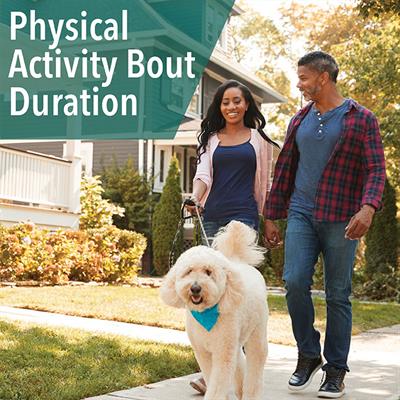Kyle Sprow, MPH, CSCS |
Aug.
2, 2019

Traditionally, physical activity recommendations have focused on accumulating moderate-to-vigorous physical activity (MVPA) either in a continuous manner, such as going for a 30-minute run, or in short bouts performed throughout the day (i.e. three bouts of 10 minutes). These recommendations were supported by the 1996 U.S. Surgeon General’s Report on Physical Activity and Health. Nearly a decade later, the 2008 Physical Activity Guidelines for Americans (PAG) supported similar recommendations, stating that “aerobic activity should be performed in episodes of at least 10 minutes.”
The primary recommendations from these two reports are similar1 and provide many examples for how people can engage in MVPA that aligns with their physical capabilities and personal preferences. The table below highlights several examples of MVPA that were used in the Surgeon General’s Report and the 2008 PAG. These examples illustrate the relationship between duration and intensity; that is, less strenuous activities require a longer duration to elicit comparable health-benefits.
|
1996 Surgeon General’s Report on Physical Activity and Health
|
2008 Physical Activity Guidelines for Americans
|
- Brisk walk for 30 minutes (moderate)
- Playing volleyball for 45 minutes (moderate)
- Raking leaves for 30 minutes (moderate)
- Swimming laps for 20 minutes (moderate-to-vigorous*)
- Playing basketball for 15-20 minutes (moderate-to-vigorous*)
- Running 1.5 miles in 15 minutes (vigorous)
|
- Brisk walking for 30 minutes on 5 days / week (moderate)
- Running for 25 minutes on 3 days / week (moderate)
- Aerobic dance class for 30 minutes once/week (vigorous); 30 minutes of running once/week (vigorous); 30 minutes of brisk walking once/week (moderate)
|
*Note: Depending on the intensity, an activity can be moderate or vigorous intensity. One minute of vigorous physical activity is equal to approximately two minutes of moderate physical activity
The 2018 Physical Activity Guidelines Advisory Committee (PAGAC) recognized that most daily activity is sporadic and is typically performed in bouts that are less than 10 minutes in duration. Additionally, many behavioral recommendations that emerged from the 2008 PAG, such as climbing stairs or parking the car farther away, did not support the notion that aerobic activity should be performed in episodes of at least 10 minutes. With the advent of accelerometers and technological improvements in physical activity trackers, the PAGAC felt it was important to review the current scientific landscape to determine whether physical activity bouts of less than 10 minutes provided health benefits, or if the benefits of physical activity were only achieved when the bout of activity was at least 10 minutes.
To address this issue, the 2018 PAGAC extended its review of the literature to include observational studies since, due to prior recommendations, randomized control trials did not evaluate bouts of physical activity of less than 10 minutes in duration. The committee concluded that the scientific evidence unequivocally supports that MVPA accumulated in bouts of at least 10 minutes can improve a variety of health-related outcomes. Additionally, the evidence also suggests that MVPA, accumulated in bouts of less than 10 minutes, is associated with favorable health-related outcomes, including improvements in:
- Body Mass Index, adiposity and obesity
- Resting blood pressure
- Cholesterol and triglycerides
- Fasting glucose, fasting insulin and HbA1c
- Metabolic syndrome
- C-reactive protein
- Cardiovascular risk score
- Frailty
- Multimorbidity
- All-cause mortality
The findings by the 2018 PAGAC that engaging in any amount of MVPA, regardless of the length of the bout, have health-enhancing effects, and led to the removal of the 10-minute bout criteria in the Physical Guidelines for Americans, 2nd edition. This is of particular importance for individuals who are unwilling or unable to engage in physical activity for at least 10 minutes. Additionally, these findings will have an extensive impact on physical activity surveillance and health messaging.
While further research is needed to strengthen the emerging evidence that the total amount of physical activity, regardless of intensity and bout duration, is beneficial to one’s health, it is important to acknowledge this potential paradigm shift in physical activity research and recommendations. The key message is that any amount of MVPA counts and whether it be taking the stairs, parking further away or going for a short walk, there are many “little” things we can do to substantially improve our health.
Learn more about the Physical Activity Guidelines for Americans, 2nd Edition
1] The primary recommendation from the Surgeon General’s Report on Physical Activity and Health was to expend about 150 calories of energy per day, or 1000 calories per week for health benefits, whereas the key guidelines for the 2008 PAG encourages adults to achieve 150 minutes of MVPA per week for substantial health benefits.
Kyle Sprow, MPH, CSCS is a Cancer Research Training Award Fellow with the National Cancer Institute. He was part of the federal staff that supported the Physical Activity Guidelines Advisory Committee and the development of the second edition of the Physical Activity Guidelines for Americans.